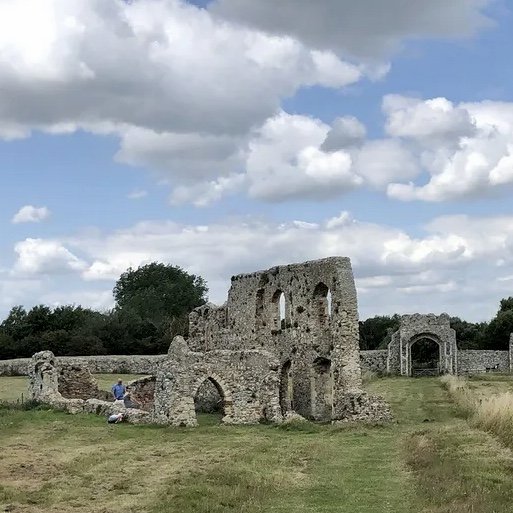Is Atlantis here in East Anglia?
A few days ago we decided to walk along the shoreline at one of our unspoilt coastal villages. It was a sunny day but with a strong, cold easterly wind which certainly blew the cobwebs away. I love this part of the coast line as it is unspoilt as nature intended.
Midway between the town of Aldeburgh and the seaside resort of Southwold, two popular spots on Britain's Suffolk coast, lies the quiet rural village of Dunwich. Around 200 people live in this one-road settlement with its cosy pub The Ship, local museum, long gravel beach which also is sandy when the tide retreats and monastery ruins.
The sea has been the making and breaking of Dunwich. It was the sea that provided the very reason for its existence and supported its industries of shipbuilding and fishing. It was the sea that brought its most famous figure, St Felix of Burgundy, a missionary invited by King Sigebert, to preach Christianity to the pagans of East Anglia and rewarded with a bishopric and a cathedral at Dunwich in ad 630.
You wouldn't know it now, but in the Middle Ages the village was a thriving port the size of the City of London's square mile, built on fishing, trade and religious patronage. Greyfriars Monastery was established by Franciscan monks in the 1250s on lower-lying ground closer to the sea.
But a massive storm in 1286 swept away the monastery, along with many homes and other buildings. The crumbling stone walls you can visit today are the remains of the "new" friary, rebuilt in the late 13th Century on land half a mile from the sea. They now stand perilously close to the edge of the cliffs – illustrating how storms, surges and coastal erosion turned the tide on thriving Dunwich, some of which was later built on higher ground.
The ruins you see today are remains of a 13th-Century monastery, built to replace the one swept away by the sea.
In the intervening years a legend arose that the medieval town remained intact below the surface of the water: Britain's very own "Atlantis". Locals have even claimed that at certain stormy times you can hear the church bells ringing.
"This stretch of coastline has a ghostly quality," said novelist Esther Freud, great-granddaughter of Sigmund, who lives in nearby Walberswick; her grandparents migrated to the area after fleeing Nazi Germany. "Walking along the shoreline on a misty day, you feel the past and present intermingled in this strange liminal space between land and sea."
This stretch of coastline has a ghostly quality.
Experts, however, thought the old town would have long ago been broken up by the waves and washed away. That is, until evidence began to emerge that this legend of "Britain's Atlantis" was not just a fanciful tale, but that medieval Dunwich – in at least some of its former glory – was out there, just metres from the shore.
From around the 1960s, fishermen began to report nets snagging on something below the surface of the water where the old town used to stand. These reports prompted local marine archaeologist and diver Stuart Bacon to search for the remains of the last church to be taken by the sea: All Saints, which finally tumbled from the cliffs in 1911.
Although the North Sea is hostile and usually has almost zero visibility, Bacon persisted. On a rare clear day in 1972, he saw the church's tower looming through the water – covered in pink sponges and crawling with crabs and lobsters. A subsequent dive also revealed the ruins of another church, St Peter's.
Within a square mile just off the shore of modern Dunwich, Sear another marine archaeologist and his team were able to locate medieval Blackfriars monastery using sonar equipment as well as St Nicholas Church, St Peter's Church, All Saints, St Katherine's Chapel and chunks of masonry that could have been the town hall and various port buildings. The mythical lost town of Dunwich was not lost at all, but lying on the seabed – almost exactly where the Tudor map maker and the old storytellers claimed it would be.
Within the next 50 years scientists think that due to a drifting sandbank off the beach at Dunwich and the erosion of the cliffs the old thirteenth century town will appear from the sea bed giving the world the first glimpse of this busy East Anglian port for centuries.
Dunwich Folklore
Due to its unfortunate history, Dunwich is also home to The Dark Heart of Dunwich is piece of a Suffolk folklore, the origins of which appear to lie in the twelfth century. The legend tells of how Eva, a Dunwich maiden due to be married to the son of a local landowner, fell instead for a good-looking local cad, who had his way with her and then deserted her, running off to sea. After waiting in vain for her lost love to return, she cut out her heart and hurled it into the sea. However, according to the legend, she was unable to die, and still haunts the area, particularly around the (constantly shifting) beach, where the land meets the sea. The heart itself, believed to be similar in appearance to a wooden heart, is believed to wash up occasionally, and bring great misfortune onto anyone who picks it up.
The cliffs at Dunwich are still the home to the Greyfriars Priory.
The Priory is a stunning ruin. It's in good condition and untouched by graffiti or other vandalism. Unusual for a building like this. But pity anyone foolish enough to deface this building, they might find themselves attracting more than the just police. You see, not all of the monks left. Their ghosts have been seen walking the hollow shell of a building and its vast grounds, scaring visitors and locals alike.
In 1926 there was even a sighting of the Black Shuck itself here, running through the grounds of the Priory. A great black beast of a dog, with glowing eyes, the Shuck has been spotted up and down the Suffolk coast and is one of England's most famous phantom hounds.
Further along the cliffs are thick woodlands and then Dunwich Heath.
Tall trees reach to the sky, their thick canopy dimming the sun and giving shelter to not one, but two ghosts. Here you might spot a Victorian squire on a horse, galloping through the brush. Or you might spot the spirit of a local gentleman who supposedly died of heartbreak in those very woods after failing to gain his families permission to marry his true love. Forlorn and alone, his ghost is seen moving through the trees, perhaps looking for his beloved so that they can at least be united in death. Unfortunately for him, her grave was most likely one of the many washed into the sea.
Dating back to the 12th century, the only sign of the leper colony that was in Dunwich are the remains of the chapel, the sea took the rest. Its a place of quiet remembrance, but also of creeping horror as it is said to be haunted by shuffling, malformed shadow people.
Now back down to the beach and, if you're lucky enough to avoid the Black Shuck as it roams the cliffs above, you might find yourself face to face with the ghost of brightly dressed Elizabethan sailor. A harmless spirit this, not out to spook or scare, he simply wants to take a slow walk down the beach to his ship. If you don't see the sailor then you might get lucky and experience the beaches other haunting, if you can call it that. Its said that sometimes, over the soft whisper of the sea breeze and the lapping of the waves on the shingle, you might hear the melancholy tolling of a church bell, rising from under the waves, the sound of the lost churches of Dunwich.
We didn’t experience any of these ghostly hauntings on our visit but that doesn’t mean that they are not there!





